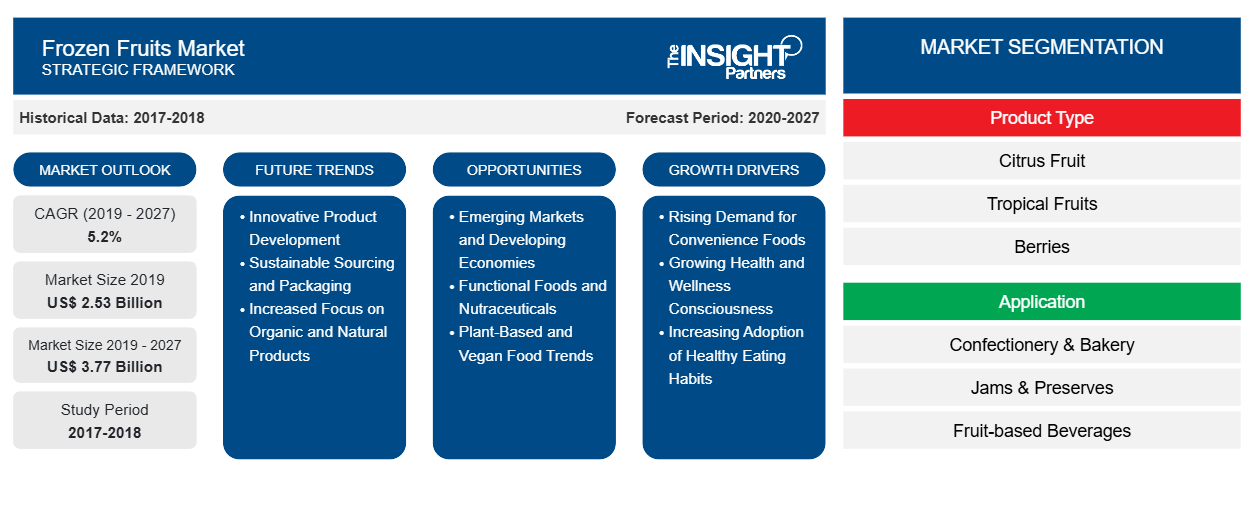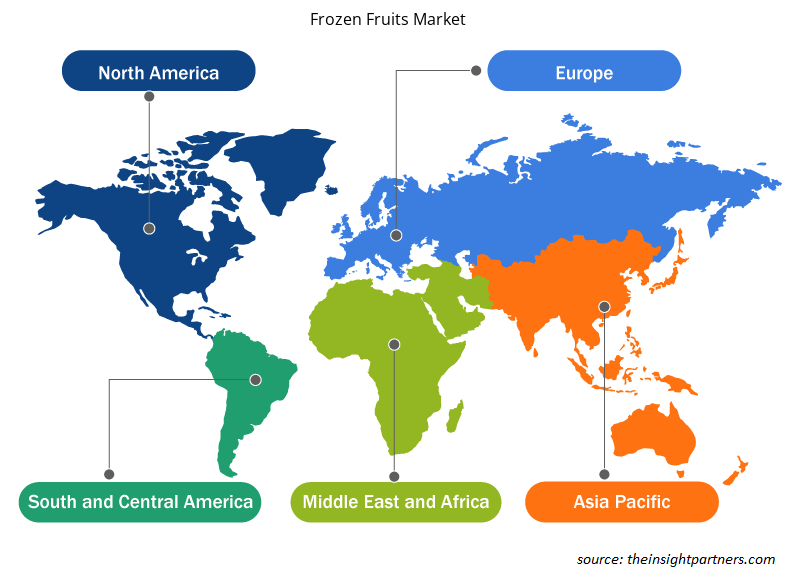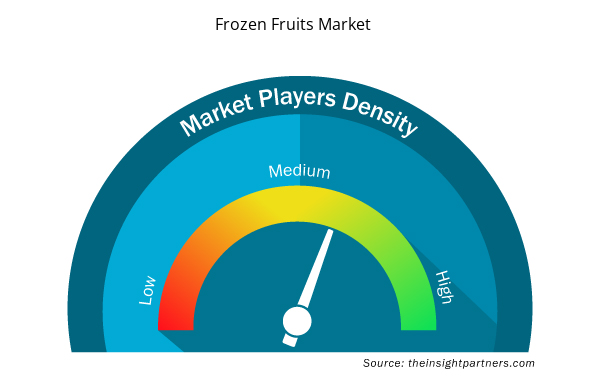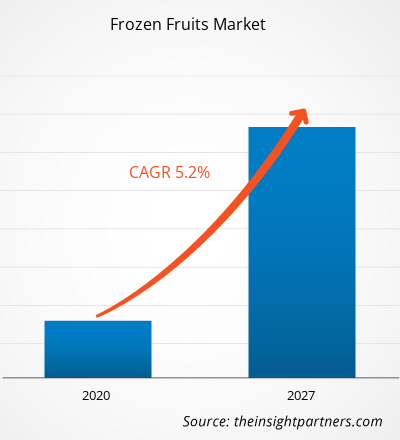[Research Report] The frozen fruits market was valued at US$ 2,528.46 million in 2019 and is projected to reach US$ 3,769.45 million by 2027; it is expected to grow at a CAGR of 5.2% during the forecast period.
Fruits picked at their peak ripeness are quickly frozen and packaged at liquid nitrogen temperature. The process provides increased shelf life to the fresh fruits. Like fresh fruits, frozen fruits are enriched with various antioxidants, minerals, and vitamins. However, the easy availability of frozen fruits, especially the seasonal ones, compared to fresh fruits has been fueling their demand globally.
In 2019, Europe held the largest share in the global frozen fruits market, followed by North America and Asia Pacific. Germany and France are dominating the frozen fruits market in Europe. In addition to growing population, rising disposable income and busy lifestyles, propelling the demand for convenience snacking, support the growth of the frozen fruits market in Europe. Additionally, the rising focus of frozen fruit producers on launching new varieties of frozen fruits to attract larger number of consumers has further fueled the market growth in the European countries.
COVID-19 outbreak first began in Wuhan (China) during December 2019, and since then, it has spread at a fast pace worldwide. As of November 2020, the US, Brazil, India, Russia, South Africa, Mexico, and the UK are a few of the worst-affected countries in terms confirmed cases and reported deaths. The COVID-19 outbreak has been affecting economies and industries in various countries due to imposition of lockdowns, travel bans, and business shutdowns. Food & beverages is one of the major industries suffering serious disruptions such as supply chain breaks, technology events cancellations, and office shutdowns. The shutdown of various plants and factories in regions such as North America, Europe, and Asia Pacific is affecting the global supply chains and negatively impacting the manufacturing, delivery schedules, and sales. Moreover, the global travel bans are affecting the business collaborations and partnerships opportunities. The disruption of operations in the food & beverages industry further has been limiting the frozen fruits market growth in various countries.
Customize This Report To Suit Your Requirement
You will get customization on any report - free of charge - including parts of this report, or country-level analysis, Excel Data pack, as well as avail great offers and discounts for start-ups & universities
Frozen Fruits Market: Strategic Insights

- Get Top Key Market Trends of this report.This FREE sample will include data analysis, ranging from market trends to estimates and forecasts.
You will get customization on any report - free of charge - including parts of this report, or country-level analysis, Excel Data pack, as well as avail great offers and discounts for start-ups & universities
Frozen Fruits Market: Strategic Insights

- Get Top Key Market Trends of this report.This FREE sample will include data analysis, ranging from market trends to estimates and forecasts.
Market Insights
Growing Demand from Packaged and Processed Food Industries
Frozen fruits are enriched with vitamins, proteins, carbohydrates, antioxidants, and other nutrients. They are used in various food cuisines for adding nutritional content and flavor. These fruits find applications in food processing industries and are used in bakery products, confectioneries, and other packaged food items. They are used in making jams and other fruit spreads, fruit-based beverages, and dairy products. Owing to busy and hectic lifestyles, there is a noticeable increase in the consumption of these ready-to-eat food products and beverages since the past few years. Moreover, rising disposable income and improving economic conditions are encouraging consumers in developed and developing countries to spend on packaged food, including snacks and bakery products, which further propels the demand for frozen fruits. Furthermore, the diversification of distribution channels has provided a shelf for convenience food in retail outlets and supermarkets, thereby uplifting their sales. Thus, the growing demand from the packaged and processed food industries, and direct consumers drives the frozen fruits market.
Product Type Insights
The frozen fruits market, by product type, is segmented into citrus fruits, tropical fruits, berries, and others. In 2019, the tropical fruits segment dominated the frozen fruits market. Many frozen tropical fruits such as mango, papaya, apple, litchi, banana, dragon fruit, plum, guava, and passion fruit are trending worldwide. In addition to freezing, the producers may also process these fruits by washing, peeling, grading, cutting, blanching, deactivating enzyme activity, etc., depending on the form preferred for the final product. Frozen tropical fruits are used in fruit cocktails, smoothies, ice cream, desserts, preservatives, pastries, yogurts, and drinks. A few tropical fruits primarily used in the processing of ethnic foods include frozen mangoes (chutney), frozen avocado (guacamole), and guavas (Ponche Navideño). Growing applications of tropical fruits in various products is expected to propel the market of this segment.
Application Insights
Based on application, the frozen fruits market is segmented into confectionery & bakery, jams & preserves, fruit-based beverages, dairy, and others. In 2019, confectionery and bakery segment dominated the frozen fruits market. Frozen Fruits are increasingly being used in bakery and confectionery products, and dairy products such as yoghurt and ice cream. Furthermore, the demand for frozen fruits from the fruit-based beverages segment has considerably risen due the surging preference of consumers for healthy beverages. The increasing inclination toward organic food products also stimulates the frozen fruits market growth.
Technique Insights
Based on technique, the frozen fruits market is segmented into freeze drying and individual quick freezing (IQF). The freeze drying segment accounted for a larger share in market in 2019, and individual quick freezing segment is expected to register the fastest CAGR during 2020–2027. Freeze-drying involves freezing the fruit and then putting it in vacuum. Low pressure allows ice crystals to grow exponentially, turning them straight from solid ice into water vapor. This method extracts water even more quickly than the conventional drying process. Effectively, the fruit's water content is decreased without hampering its composition. This method of preserving food is best suited to low-sugar, soft fruits such as raspberries and strawberries. Frozen-drying provides long shelf life to fruits, allowing them to last many years when preserved properly.
Key market players include Crop's Fruits NV, Dole Packaged Foods LLC., MireliteMirsa Co. Ltd., SunOpta Inc., Titan Frozen Fruits, Wawona Frozen Foods, Welch Foods, Inc., Greenyard, J.R. Simplot Company, and General Mills Inc. The companies have been adopting strategies such as mergers and acquisitions. The major players are striving to acquire larger customer base by expanding their presence globally.
Frozen Fruits Market Regional Insights
The regional trends and factors influencing the Frozen Fruits Market throughout the forecast period have been thoroughly explained by the analysts at Insight Partners. This section also discusses Frozen Fruits Market segments and geography across North America, Europe, Asia Pacific, Middle East and Africa, and South and Central America.

- Get the Regional Specific Data for Frozen Fruits Market
Frozen Fruits Market Report Scope
| Report Attribute | Details |
|---|---|
| Market size in 2019 | US$ 2.53 Billion |
| Market Size by 2027 | US$ 3.77 Billion |
| Global CAGR (2019 - 2027) | 5.2% |
| Historical Data | 2017-2018 |
| Forecast period | 2020-2027 |
| Segments Covered |
By Product Type
|
| Regions and Countries Covered | North America
|
| Market leaders and key company profiles |
Frozen Fruits Market Players Density: Understanding Its Impact on Business Dynamics
The Frozen Fruits Market is growing rapidly, driven by increasing end-user demand due to factors such as evolving consumer preferences, technological advancements, and greater awareness of the product's benefits. As demand rises, businesses are expanding their offerings, innovating to meet consumer needs, and capitalizing on emerging trends, which further fuels market growth.
Market players density refers to the distribution of firms or companies operating within a particular market or industry. It indicates how many competitors (market players) are present in a given market space relative to its size or total market value.
Major Companies operating in the Frozen Fruits Market are:
- Greenyard
- Titan Frozen Fruit
- Dole Packaged Foods LLC.
- Sunopta Inc.
- J.R. Simplot Company
Disclaimer: The companies listed above are not ranked in any particular order.

- Get the Frozen Fruits Market top key players overview
Report Spotlights
- Progressive industry trends in the global frozen fruits market to help players develop effective long-term strategies
- Business growth strategies adopted by companies to grow in developed and developing markets
- Quantitative analysis of the global frozen fruits market from 2017 to 2027
- Estimation of the demand for frozen fruits across various industries
- PEST analysis to illustrate the efficacy of buyers and suppliers operating in the industry to predict market growth
- Recent developments to understand the competitive market scenario and demand for frozen fruit
- Market trends and outlook as well as factors driving and restraining the growth of the frozen fruits market
- Understanding on strategies that underpin commercial interest with regard to global frozen fruits market growth to facilitate decision-making process for stakeholders
- Frozen fruits market size at various nodes of market
- Detailed overview and segmentation of the global frozen fruits market as well as its dynamics in the industry
- Frozen fruits market size in various regions with promising growth opportunities
Frozen Fruits Market, by Product Type
- Citrus Fruit
- Tropical Fruits
- Berries
- Others
Frozen Fruits Market, by Application
- Confectionery & Bakery
- Jams & Preserves
- Fruit-based Beverages
- Dairy
- Others
Frozen Fruits Market, by Technique
- Freeze Drying
- Individual Quick Freezing
Company Profiles
- Crop's Fruits NV
- Dole Packaged Foods LLC.
- MireliteMirsa Co. Ltd.
- SunOpta Inc.
- Titan Frozen Fruits
- Wawona Frozen Foods
- Welch Foods Inc.
- Greenyard
- J.R. Simplot Company
- General Mills Inc
- Historical Analysis (2 Years), Base Year, Forecast (7 Years) with CAGR
- PEST and SWOT Analysis
- Market Size Value / Volume - Global, Regional, Country
- Industry and Competitive Landscape
- Excel Dataset


- Hydrogen Storage Alloys Market
- Single-Use Negative Pressure Wound Therapy Devices Market
- Genetic Testing Services Market
- Cut Flowers Market
- Enteral Nutrition Market
- Health Economics and Outcome Research (HEOR) Services Market
- Flexible Garden Hoses Market
- Ketogenic Diet Market
- Point of Care Diagnostics Market
- Digital Language Learning Market

Report Coverage
Revenue forecast, Company Analysis, Industry landscape, Growth factors, and Trends

Segment Covered
Product Type ; Application ; Technique , and Geography

Regional Scope
North America, Europe, Asia Pacific, Middle East & Africa, South & Central America

Country Scope
Argentina, Australia, Brazil, Canada, China, France, Germany, India, Italy, Japan, Mexico, Russian Federation, Saudi Arabia, South Africa, South Korea, United Arab Emirates, United Kingdom, United States
Frequently Asked Questions
Based on type, why is the berries segment expected to grow at the highest rate during 2019–2027?
The growth of the berries segment is primarily attributed to the fact that berries include frozen raspberries, strawberries, blackberries, blueberries, chokeberries, cherries, black currant, mulberries, cranberries, gooseberries, red currants, and others. North America and Europe have experienced a high market for blackberries and raspberries. Warm weather across the globe has taken a toll on the steady production of berries, increasing the demand for frozen varieties. Frozen berries are among the healthiest foods that are tasty, nutritious, and have a range of fantastic health benefits. The frozen blueberries have many health benefits such as improved digestion, improved heart health, improved motor function, reduced risk of forms of dementia and Alzheimer's disease, and improved nervous system health. Health benefits associated with berries is expected to drive the growth of this segment. All these factors are responsible for the berries segment to grow at the highest rate.
Can you list some of the major players operating in the global frozen fruits market?
The major players operating in the global frozen fruits market are Greenyard, Crop's Fruits NV, Mirelite Mirsa Co. Ltd., Wawona Frozen Foods, Welch Foods, Inc, J.R. Simplot Company, General Mills Inc, Dole Packaged Foods LLC, Sunopta Inc, and Titan Frozen Fruit among many others.
Which region held the largest share of the global frozen fruits market?
In 2018, the frozen fruits market was predominant in Asia-Pacific at the global level. Surge in demand of frozen fruits in various food processing industries such as bakery, confectionery & other packaged food items like bread, cakes, and pastry has had a noteworthy influence on the frozen fruits market in Asia- Pacific. The market for frozen fruits in Asia- Pacific is witnessing growth owing to the presence of well-established players such as SunOpta Inc., Greenyard, and Dole Packaged Foods LLC. and others in this region. With the rise in demand for the healthy and convenience food among the consumers in the region is expected to continue to grow over the projected period. The popularity of the frozen fruits has increased within the region, particularly in Australia, China, India, Japan, South Korea, and Rest of APAC. Its use in food and beverages industry has had a noteworthy influence on the frozen fruits market in Asia- Pacific. Owing to busy & hectic lifestyles, there is a noticeable increase in the consumption of these ready-to-eat food products and beverages over the past few years which will further support product demand. Also, the swift in the middle- class population, along with growth in urbanization and rise in disposable income available in the hands of people, leads to the rise in demand for both frozen fruits & convenience food is also anticipated to fuel the market size over the forecast period. The market for frozen fruits is picking up pace in this region, owing to the development of new manufacturing industries together with the government support to increase the industrial production in food and beverages sector.
Trends and growth analysis reports related to Food and Beverages : READ MORE..
The List of Companies - Global Frozen Fruits Market
- Greenyard
- Titan Frozen Fruit
- Dole Packaged Foods LLC.
- Sunopta Inc.
- J.R. Simplot Company
- General Mills Inc.
- Welch Foods, Inc.
- Wawona Frozen Foods
- Mirelite Mirsa Co. Ltd.
- Crop's Fruits NV

 Get Free Sample For
Get Free Sample For